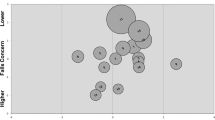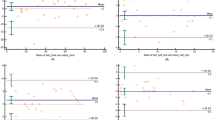Abstract
Study design
Clinimetric Study.
Objectives
To translate and cross-cultural adapt the Capabilities of Upper Extremity (CUE) questionnaire into Hindi Language and assess the psychometric properties of the CUE-Hindi (CUE-H).
Setting
Indian Spinal Injuries Centre, New Delhi, INDIA.
Methods
The CUE-H translation and cross-cultural adaptation followed standardized guidelines. The pre-final version was tested for clarity and comprehensibility. Content Validity Estimation was done using both qualitative and quantitative methods. Cronbach’s alpha was used for assessing the internal consistency and Intraclass Correlation Coefficient (ICC) for assessing the test-retest reliability.
Results
All steps of the translation process were followed and documented. The CUE-H was found to be comprehensive to patients and easy to administer. Content Validity estimation resulted in the retention of all the questionnaire items. The ICC was 0.99 and Cronbach’s alpha for the scale was 0.94.
Conclusions
The CUE-H demonstrated acceptable measurement properties, showing that it can be used for assessing upper limb functional limitations in Hindi-speaking people with SCI. It can be used as an assessment tool for clinical management or research.
This is a preview of subscription content, access via your institution
Access options
Subscribe to this journal
Receive 1 print issues and online access
We are sorry, but there is no personal subscription option available for your country.
Buy this article
- Purchase on Springer Link
- Instant access to full article PDF
Prices may be subject to local taxes which are calculated during checkout

Similar content being viewed by others
Data availability
Not applicable
References
American Spinal Injury Association International Standards for Neurological Classification of Spinal Cord injury. American Spinal Injury Association (2002).
Singh A, Tetreault L, Kalsi-Ryan S, Nouri A, Fehlings MG. Global prevalence and incidence of traumatic spinal cord injury. Clin Epidemiol. 2014;6:309–31.
Raineteau O, Schwab ME. Plasticity of motor systems after incomplete spinal cord injury. Nat Rev Neurosci. 2001;2:263–73.
Levy WJ, Amassian VE, Traad M, Cadwell J. Focal magnetic coil stimulation reveals motor cortical system reorganized in humans after traumatic quadriplegia. Brain Res. 1990;510:130–4.
Kumar S, Khushboo, Panwar P, Garg S, Kalra S, Yadav J. Translation and cross-cultural adaptation of spinal cord independence measure version III in hindi language. Ann Indian Acad Neurol. 2020;23:98–102.
Srikesavan C, Bhardwaj P, Gobinath K, Ramalingam AT, Sabapathy S. Tamil Translation, Cross-Cultural Adaptation, and Pilot Testing of the Disabilities of Arm, Shoulder, and Hand Questionnaire. Indian J Orthop. 2019;53:602–6.
Marino RJ, Shea J, Stineman MG. The Capabilities of Upper Extremity Instrument: reliability and validity of a Measure of Functional limitation in Tetraplegia. Arch Phys Med Rehabilitation. 1998;79:1512–21.
Oleson CV, Marino RJ. Responsiveness and concurrent validity of the revised Capabilities of Upper Extremity-Questionnaire (CEU-Q) in patients with acute tetraplegia. Spinal Cord. 2014;52:625–8.
Capabilities of Upper Extremity Instrument. Available from: https://scireproject.com/outcome-measures/list-sci/upper-limb/capabilities-of-upper-extremity-instrument-cue/.
Mehta SP, Mhatre B, MacDermid JC, Mehta A. Cross-cultural Adaptation and Psychometric Testing of the Hindi Version of the Patient-rated Wrist evaluation. J Hand Ther. 2012;25:65–78.
Jain M, Tandon S, Sharma A, Jain V, Yadav NR. Cross-cultural adaptation, validity and reliability of a Hindi version of the Corah’s Dental Anxiety Scale. Health Promotion Perspect. 2018;8:120–6.
Moiz JA, Bansal V, Noohu MM, Gaur SN, Hussain ME. Cross-cultural adaptation and psychometric analysis of the hindi-translated activities-specific balance confidence scale. Middle East J Rehabil Health Stud. 2016;3:e34886.
World Health Organization. Process of translation and adaptation of instruments. Available from: https://www.who.int/substance_abuse/research_tools/translation/en/.
McKenzie JF, Wood ML, Kotecki JE, Clark JK, Brey RA. Establishing content validity: using qualitative and quantitative steps. Am J Health Behav. 1999;23:311–8.
Lawshe CH. A quatitative approach to content validity. Pers Psychol. 1975;28:563–75.
Maki D, Rajab E, Watson PJ, Critchley DJ. Cross-cultural translation, adaptation, and psychometric testing of the Roland-Morris disability questionnaire into modern standard Arabic. Spine (Philos Pa 1976). 2014;39:E1537–44.
Hertel-Joergensen M, Abhrahamsen C, Jensen C. Translation, adaptation and psychometric validation of the Good Perioperative Nursing Care Scale (GPNCS) with surgical patients in perioperative care. Int J Orthopedic Trauma Nurs. 2018;29:41–48.
Cha ES, Kim KH, Erlen JA. Translation of scales in cross‐cultural research: issues and techniques. J Adv Nurs. 2007;58:386–95.
Fleiss, JL Design and analysis of clinical experiments. New York: Wiley (1984).
Acknowledgements
We would like to extend our heartfelt thankfulness to all the professionals and the persons with SCI who gave their valuable inputs in the different steps involved in the development of the CUE-H.
Author information
Authors and Affiliations
Contributions
Dr. Ruby Aikat—Conceptualization of the research, Ethical concerns, data analysis, manuscript writing. Soumya Prasad—Data collection, manuscript writing.
Corresponding author
Ethics declarations
Competing interests
The authors declare no competing interests.
Additional information
Publisher’s note Springer Nature remains neutral with regard to jurisdictional claims in published maps and institutional affiliations.
This study received the Gold Medal Award for the Best Poster Presentation -Rehabilitation Medicine at the ISSICON 2017, New Delhi, INDIA.
Rights and permissions
Springer Nature or its licensor (e.g. a society or other partner) holds exclusive rights to this article under a publishing agreement with the author(s) or other rightsholder(s); author self-archiving of the accepted manuscript version of this article is solely governed by the terms of such publishing agreement and applicable law.
About this article
Cite this article
Aikat, R., Prasad, S. Cross-cultural adaptation, validity and reliability of the Hindi version of the capabilities of upper extremity (CUE-H). Spinal Cord Ser Cases 9, 50 (2023). https://doi.org/10.1038/s41394-023-00606-1
Received:
Revised:
Accepted:
Published:
DOI: https://doi.org/10.1038/s41394-023-00606-1



